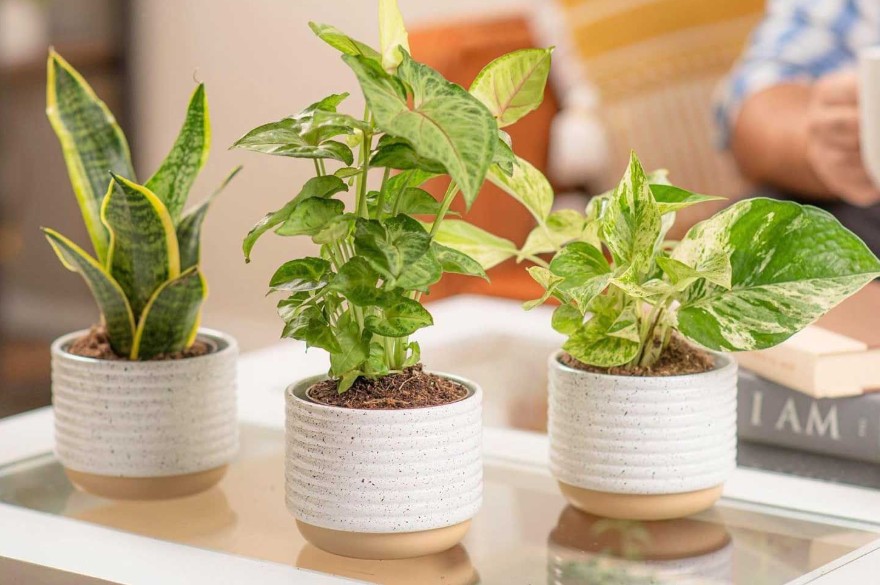Happy New Year, gardeners! While you’re making resolutions to eat better and get more exercise, spare a few thoughts for what you might do this year to make the garden outside your window look more like the garden in your mind. Here are a few gardening resolutions I’ve made (some many times!). Maybe one or two will resonate with you.

Resist “drifts of one.” Adding a few more pink astilbe would make the author’s garden more vibrant by amping up the color. Removing the overgrown hosta makes room for the added astilbe.
Resist “Drifts of One”
This is where you fall in love with a plant at the nursery but only have the budget, or space, for one. This kind of impulse buying leaves you with a disorganized garden with little visual impact. (Ask me how I know.) For a cohesive, unified look, use multiples of the same plant in the same color. Buy odd numbers –threes, fives or sevens – and plant them together in a loose cluster, allowing space for their mature size. It’s not only more visually satisfying, it makes sense. After all, in healthy ecosystems, plants are rarely orphans. They are surrounded by others of their species.

Take Photos
Not pretty pictures for Instagram or Facebook. Those are nice, but “working” photos taken throughout the year, even when (especially when) your garden isn’t camera-ready, can help get your garden where you want it to be. Take shots from different angles and locations: above, below and literally at ground-level, as well as from the street, the house, your property lines and neighbors’ properties. Pictures often reveal what the naked eye can’t, such as plants that are overgrown or blocking others, where there are gaps that need filling or where plants need to be pulled out altogether.

One of the author’s New Year’s gardening resolutions is to get rid of orphan plants, which don’t offer much visual impact, and replace them with more plants of fewer species.
Rip It Out
Is a plant not performing? Then cut it down. Shovel prune. This is a big one for me. I have trouble taking out plants that just don’t work. I keep giving them another chance, in denial that the full sun plant I just had to have is lanky, floppy and won’t bloom in its shady spot. Have the courage to appraise your space and cold-heartedly remove what isn’t thriving or doesn’t look so good next to its neighbors. If you’re concerned you’ll have regrets, pot the plant up and keep it going so you can put it back if you change your mind.

Feed the Soil, Not the Plants
When’s the last time you gave your soil a boost? It is so much more than just a medium for plant roots to grab onto. It’s a source of moisture, nutrients, beneficial microbes and fungi; all things our plants need to thrive. Pouring only liquid fertilizer on your plants, but not building the soil, is like giving them an energy drink instead of a well-balanced meal. Healthy, nutrient-rich soil makes for healthy plants that resist diseases and pests. Make a promise to incorporate compost, chopped leaves, aged manure or other organic materials into your garden beds and borders this year.

Challenge Yourself
Grow something new. Maybe it’s a vegetable you like to eat but have never tried in your garden. That’s how I discovered that Brussels sprouts plants look like something from Dr. Seuss. Or perhaps you covet a plant that’s not reliably hardy in your zone, but you’ve got a sheltered spot and can provide the conditions to keep it alive. Start plants from seed if you’ve never done it, or give topiary a try. Sharpening your skills keeps gardening exciting.

Time invested in planning your garden can help you save money and see better results. Available planning tools range from detailed computer programs to a simple pencil and paper sketch.
Make a Plan
It sounds overwhelming, but when I say, “make a plan,” I don’t mean redesigning your landscape. Think about one thing that bothered you about your garden last year, and make a plan to correct it, even if that means doing it in baby steps. There’s an unruly patch of ivy beneath a lilac that I’ve been meaning to replace with more colorful shade plants. While I’m aiming to rip out the ivy this spring, I may not get to replant the area this year. So I’ll add compost to the soil and top it with mulch to keep the weeds down until I know what I want to put there. And if I don’t do it? There’s always next year.







